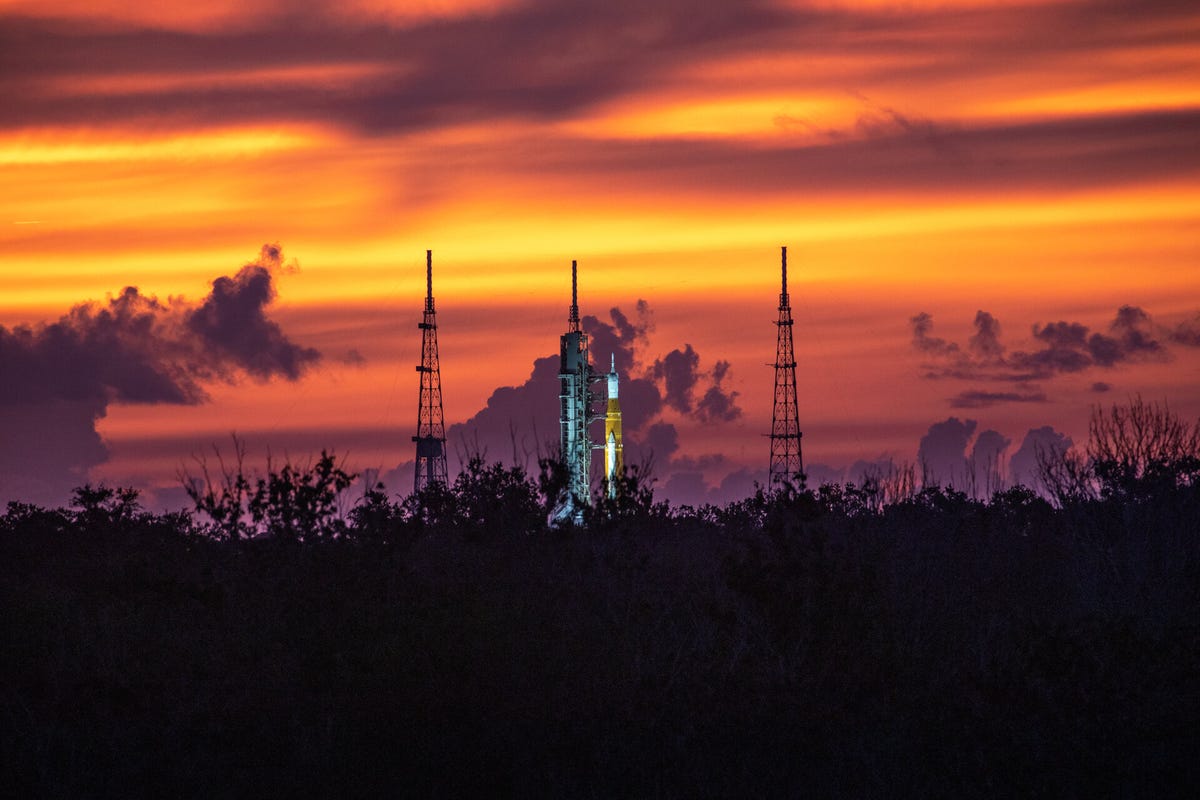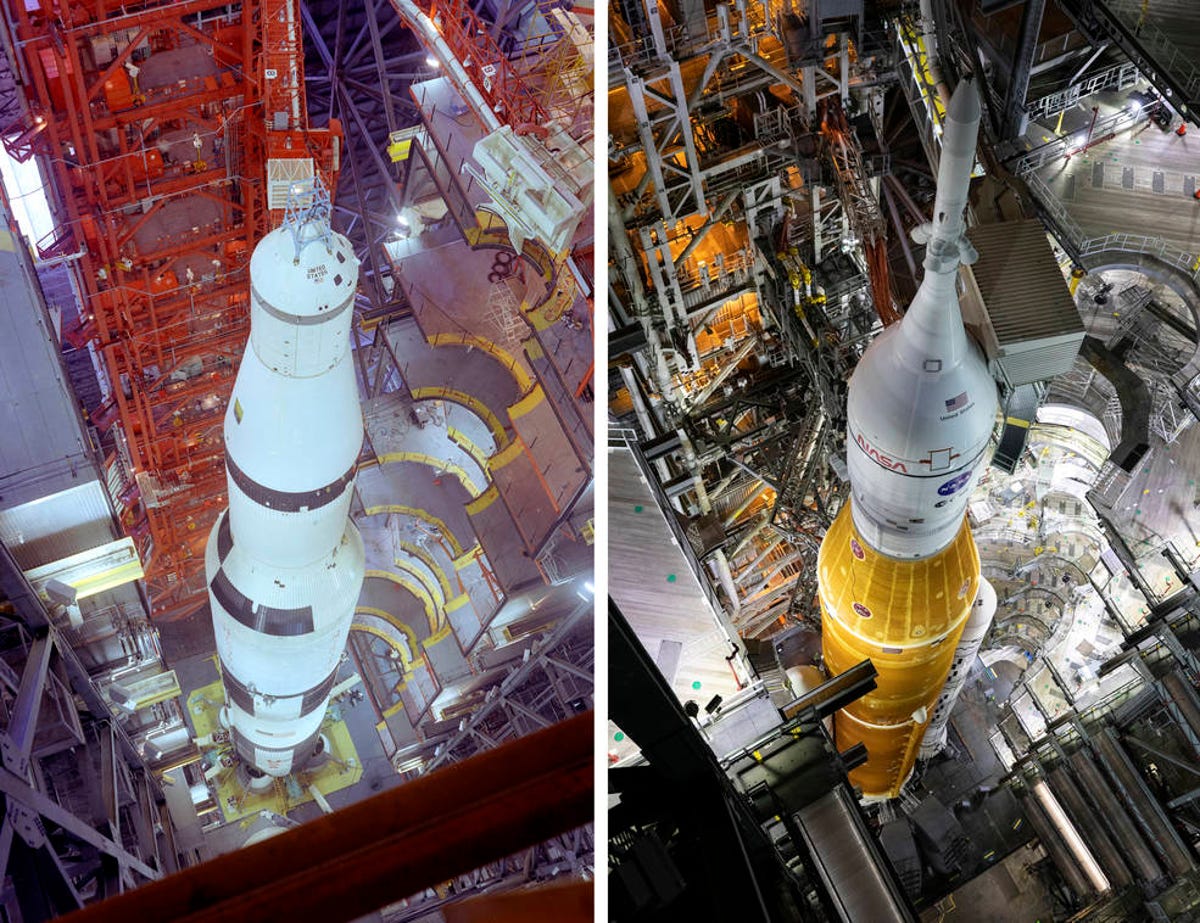
Artemis I readies for launch
"We are going." NASA's motto for its uncrewed Artemis I around-the-moon mission is full of hope for the opening of a new era of lunar exploration. The Artemis program is looking to follow in the footsteps of the legendary Apollo program of the 1960s and 1970s that took humans to the moon's surface.
The Apollo missions relied on massive Saturn V rockets to get there. Artemis is all about the Space Launch System, which NASA has referred to as a mega moon rocket. It's been decades since a human-rated spacecraft has headed for our lunar neighbor, and a few things have changed. Let's look at how Artemis compares with Apollo.
This sunrise photo shows Artemis I posing on the launchpad at Kennedy Space Center in Florida.

Apollo and Artemis, years apart
The Saturn V rocket stood a whopping 363 feet (111 meters) tall, as seen here getting ready for the Apollo 4 mission, which launched in 1967. Apollo 4 was a test mission for Saturn V, much like Artemis I will test all aspects of SLS.
On the right, SLS reaches 322 feet (98 meters) tall. Both rockets are taller than the Statue of Liberty.
Saturn V versus the Statue of Liberty
OK, so both Saturn V and SLS are taller than the Statue of Liberty, but what does that look like? This vintage NASA illustration from 1967 shows what would happen if Saturn V parked right next to the landmark.
Saturn V takes off
The Saturn V Heavy Lift Vehicle rocket was the powerhouse that carried astronauts to the moon. "The rocket generated 34.5 million newtons (7.6 million pounds) of thrust at launch, creating more power than 85 Hoover Dams," NASA said.
The Saturn V first flew in 1967 for the Apollo 4 mission. The last Saturn V took off in 1973 to escort the Skylab space station into Earth orbit. This image shows the Skylab launch.
Business end of the rockets
You might notice at least one big difference between the Saturn V rocket and SLS. Saturn V was equipped with five engines on the first stage, while the SLS core stage sports four.
Stages refer to sections of the rocket that have their own engines. Teams have to stack the rocket sections on top of each other like building a tower. "Unlike the Saturn V rocket, which had three rocket stages, SLS is powered by the mighty core stage -- with two solid rocket boosters strapped alongside -- and the upper stage, called the Interim Cryogenic Propulsion Stage, which provides the power to send the Orion spacecraft toward the moon," NASA said.
The SLS may have fewer engines on display here, but it produces 15% more thrust than Saturn V during liftoff.
Saturn V F-1 engine
Here's a look at one of the Saturn V F-1 engines that powered the first stage of the Apollo moon missions. See humans for scale. Saturn V used five of these bad boys.
SLS RS-25 engines
The SLS rocket relies on four RS-25 engines to get it off this rock. The Artemis I engines are seen lined up before they were attached to the rocket's core stage -- the big, cylindrical central section of the rocket. The RS-25 engines trace back to the space shuttle era.
"For SLS, they have been upgraded with new controllers, to perform under SLS environments and with nozzle insulation, for protection and prevention of metal overheating during launch and flight," said NASA in 2017.
Wormy boosters for Artemis I
NASA's '70s-vintage worm logo is emblazoned across the Artemis I SLS boosters. The boosters are the smaller cylinders attached on either side of the big orange core stage. The boosters do a lot of heavy lifting at launch to help the SLS and the Orion capsule get off the ground and into space.
"The SLS boosters are the largest, most powerful solid propellant booster ever built for flight," NASA said. "Standing 17 stories tall and burning approximately six tons of propellant every second, each booster generates more thrust than 14 four-engine jumbo commercial airliners."
Artemis I poses on the launchpad
Artemis I reached the launchpad in the morning on Aug. 17, 2022. An initial Aug. 29 launch got scrubbed, with NASA eying a fresh opportunity a few days down the line. This view gives a good look at the full SLS and the white boosters on either side. "Together, the SLS twin boosters provide more than 75% of the total SLS thrust at launch," said NASA.
The boosters represent a big difference from the Apollo-era Saturn V, which didn't use boosters.
Moon rocket stages hang tight
Both Saturn V and SLS made themselves at home inside NASA's massive Vehicle Assembly Building (VAB) at Kennedy Space Center in Florida. These images shows NASA's first Saturn V moon rocket on the left, with the first SLS core stage on the right. The VAB is where NASA teams stack the rocket systems, putting all the stages and components together before mounting the spacecraft on the top. They may come from different eras, but both were stacked in the same building.
Saturn V and SLS hang out
If you enjoyed the previous view of the Saturn V first stage and the Artemis I core stage, feast your eyes on this different angle seen inside the Vehicle Assembly Building, a massive structure that acts like a rocket garage.
Vehicle Assembly Building
The Vehicle Assembly Building at the Kennedy Space Center in Florida got spruced up ahead of the Artemis moon missions with new logos. The blue NASA meatball is 110 feet (34 meters) tall. It takes a big building -- one of the largest in the world by area -- to house rockets that are taller than the Statue of Liberty. VAB was completed in 1966.
As NASA notes, the VAB is "the only facility where assembly of a rocket occurred that carried humans beyond low-Earth orbit and on to the moon."
Apollo and Orion spacecraft
On the left, the Apollo 10 spacecraft is lifted to a work stand in 1969. On the right, the Artemis I Orion spacecraft is lifted out of a work stand in 2021. The two capsules share a familiar shape. Apollo 10 carried a crew, while this Orion spacecraft is set to carry manikins instead of humans.
Apollo 10, which went into orbit around the moon, acted as a dress rehearsal for the human lunar landing of Apollo 11, so it's comparable to what NASA wants to do with the Artemis II mission that will send astronauts around the moon.
Setting the stage for the moon
The Saturn V rocket had three stages that helped to propel the spacecraft for the moon missions. We saw the first stage earlier in this gallery. The image on the left shows the second stage as it looked when being stacked on top of the first.
On the right is the SLS Interim Cryogenic Propulsion Stage, which is designed to give the Orion spacecraft what it needs to make it out beyond the moon.
Hanging out at the VAB
Two rockets, decades apart in front of the same giant building at Kennedy Space Center in Florida. The Saturn V seen on the left was for the Apollo 14 mission, which launched in 1971 to become the third crewed mission to land on the moon.
On the right, SLS emerges from the Vehicle Assembly Building in 2022. If you look back and forth, you can see how SLS is a little shorter than Saturn V. Both rockets sit on top of a huge vehicle called a crawler-transporter. These lumbering beasts slowly carry the heavy rockets out to the launchpads.
Saturn V cutaway
This vintage NASA illustration shows a cutaway of Saturn V with the major pieces labeled, including the engines, fuel tanks, lunar module and Apollo capsule.
SLS options
NASA's SLS is part of an ambitious plan not only to return humans to the moon, but also to build a sustained human presence there with the idea of using it as a stepping stone to Mars exploration. This chart shows the different ways NASA can use SLS depending on whether the missions are focused on crew or cargo and how heavy the payloads are. Artemis I is using the Block 1 configuration seen on the far left.
Saturn V launch of Apollo 11
We're still waiting for the pretty pictures of the SLS Artemis I launch. NASA scrubbed an initial launch attempt on Aug. 29 due to an engine issue. This lovely photo shows the famous Apollo 11 mission taking off in 1969. Apollo 11 delivered the first astronauts to the surface of the moon. The SLS launch promises to be just as spectacular.
Big rockets at night
Both Saturn V and SLS are cover-worthy models. On the left is Apollo 17, the final lunar landing mission of the era. It launched in late 1972. It could be years before NASA gets boots back on the moon, but Artemis I, seen on the right, is the first big step in that direction.
Where it's going...
Apollo did it first. It got humans to the moon, as this photo of astronaut Buzz Aldrin shows. Artemis I, if successful, will be the first major step in a new era of moon exploration. There won't be any people on board the Orion spacecraft for SLS's first launch, but NASA hopes the planned Artemis III mission will generate new photos of humans on the moon.

